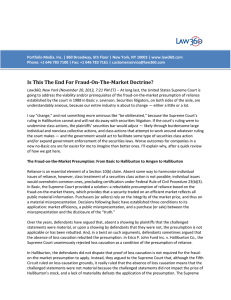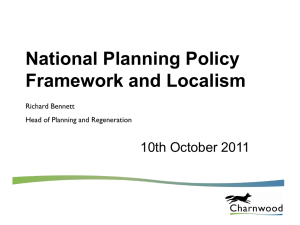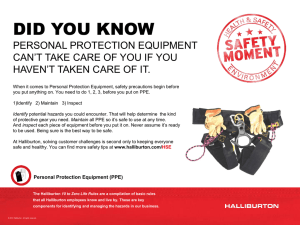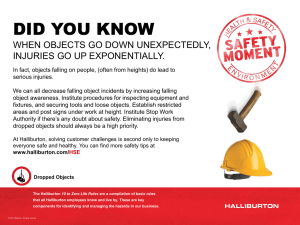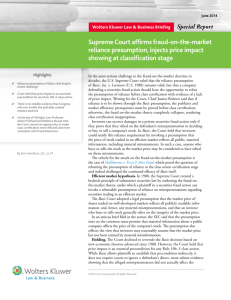U.S. Supreme Court Hears Arguments on Critical Issue for Securities
advertisement
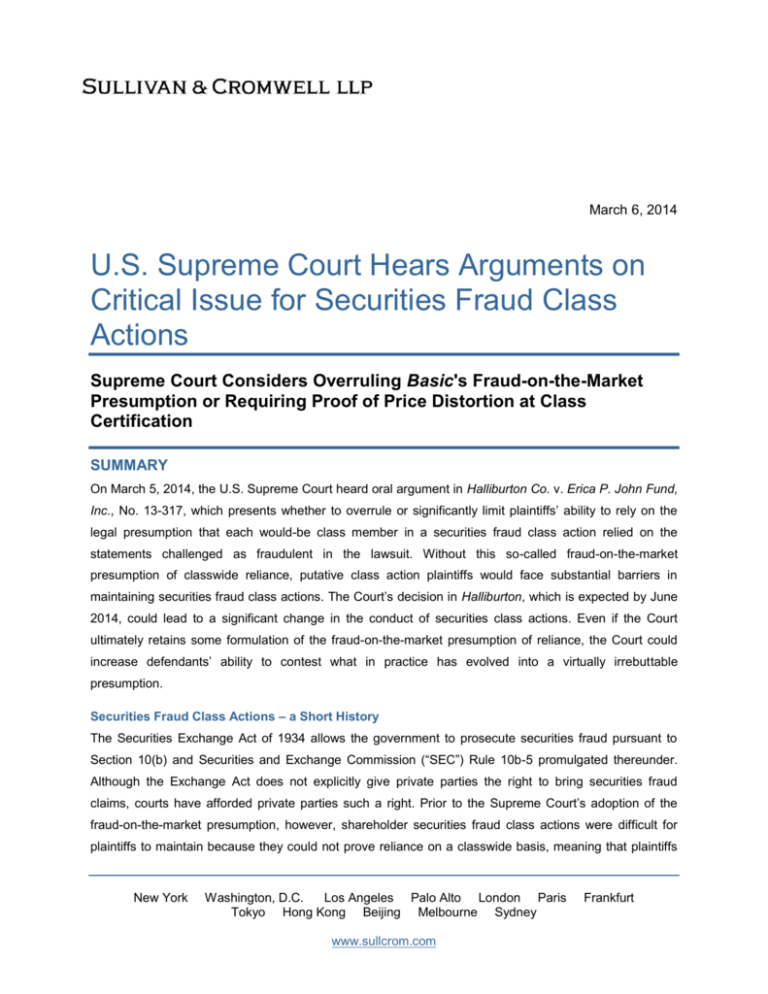
March 6, 2014 U.S. Supreme Court Hears Arguments on Critical Issue for Securities Fraud Class Actions Supreme Court Considers Overruling Basic's Fraud-on-the-Market Presumption or Requiring Proof of Price Distortion at Class Certification SUMMARY On March 5, 2014, the U.S. Supreme Court heard oral argument in Halliburton Co. v. Erica P. John Fund, Inc., No. 13-317, which presents whether to overrule or significantly limit plaintiffs’ ability to rely on the legal presumption that each would-be class member in a securities fraud class action relied on the statements challenged as fraudulent in the lawsuit. Without this so-called fraud-on-the-market presumption of classwide reliance, putative class action plaintiffs would face substantial barriers in maintaining securities fraud class actions. The Court’s decision in Halliburton, which is expected by June 2014, could lead to a significant change in the conduct of securities class actions. Even if the Court ultimately retains some formulation of the fraud-on-the-market presumption of reliance, the Court could increase defendants’ ability to contest what in practice has evolved into a virtually irrebuttable presumption. Securities Fraud Class Actions – a Short History The Securities Exchange Act of 1934 allows the government to prosecute securities fraud pursuant to Section 10(b) and Securities and Exchange Commission (“SEC”) Rule 10b-5 promulgated thereunder. Although the Exchange Act does not explicitly give private parties the right to bring securities fraud claims, courts have afforded private parties such a right. Prior to the Supreme Court’s adoption of the fraud-on-the-market presumption, however, shareholder securities fraud class actions were difficult for plaintiffs to maintain because they could not prove reliance on a classwide basis, meaning that plaintiffs New York Washington, D.C. Los Angeles Palo Alto London Paris Tokyo Hong Kong Beijing Melbourne Sydney www.sullcrom.com Frankfurt would need to show that each class member individually considered (and believed) the alleged fraudulent statements when buying or selling securities. In Basic Inc. v. Levinson, 485 U.S. 224 (1988), a four-Justice majority of the Supreme Court endorsed the fraud-on-the-market presumption of reliance. Under this presumption, which a defendant may rebut, an investor bringing a securities fraud claim may prove reliance without a showing that it actually was aware of and considered an allegedly material misrepresentation in making its purchase or sale of a security if (i) that misrepresentation was made publicly, and (ii) the security is traded in an efficient market. The presumption hinges on an economic theory that “an efficient market will reflect all publicly available information about a company; accordingly, a buyer of the security may be presumed to have relied on that information in purchasing the security.” Amgen, Inc. v. Conn. Ret. Plans & Trust Funds, 133 S. Ct. 1184, 1190 (2013). Absent this presumption it would be difficult for most securities fraud class actions to be certified under Federal Rule of Civil Procedure 23, because individual questions of investors’ reliance on the purported misrepresentation would outweigh common classwide issues. See id. at 1209 (Thomas, J., dissenting) (Basic presumption is what “makes securities-fraud class actions possible” because it “convert[s] the inherently individual reliance inquiry into a question common to the class”). Since the Supreme Court’s decision in Basic, the fraud-on-the-market doctrine and the efficient-market hypothesis underlying it have been the subject of sharp debate. See, e.g., id. at 1197 n.6 (noting existence of “modern economic research tending to show that market efficiency is not a binary, yes or no question” and “differences in efficiency can exist within a single market”). At least four of the current Justices expressed skepticism about Basic in their concurring and dissenting opinions in Amgen. Justice Alito noted that “recent evidence suggests that the [Basic] presumption may rest on a faulty economic premise.” Id. at 1204 (Alito, J., concurring). Justice Thomas, joined by Justices Scalia and Kennedy, similarly observed that “[t]he Basic decision itself is questionable.” Id. at 1208 n.4 (Thomas, J. dissenting). HALLIBURTON In a previous 2011 appeal of this putative class action brought on behalf of purchasers of Halliburton common stock, the Supreme Court reversed a decision denying class certification and remanded the case, ruling that the plaintiff did not need to prove affirmatively that the alleged misstatements caused plaintiffs’ losses before obtaining class certification. See Erica P. John Fund, Inc. v. Halliburton Co., 131 S. Ct. 2179 (2011). In light of that holding, the Court explained that it did not need to “address any other question about Basic, its presumption, or how and when it may be rebutted.” Id. at 2187. On remand, Halliburton argued that the plaintiff should be required to show the alleged misrepresentations had a “price effect” on the company’s stock (i.e., the price of the stock changed or was distorted due to the representations), because if there had been no price effect the fraud-on-themarket doctrine would be inapplicable and there could be no classwide basis for proving reliance. The trial court rejected this argument and certified a class, and the Court of Appeals affirmed. -2U.S. Supreme Court Hears Arguments on Critical Issue for Securities Fraud Class Actions March 6, 2014 Halliburton sought review of the decision by the Supreme Court, asking that the Court consider the “price effect” question that the trial court had rejected and also directly challenging Basic’s fraud-on-the-market presumption. On November 15, 2013, the Court granted certiorari. In doing so, the Court agreed to hear argument both on whether it should overrule Basic and on whether it should substantially modify the Basic presumption. The Parties’ Briefs In its briefs, Halliburton argued that the Court should overrule Basic because it was wrongly decided and the passage of time has only amplified the decision’s flaws. In support of this contention, Halliburton made two principal arguments: first, as a matter of statutory interpretation, the fraud-on-the-market presumption of reliance is inappropriate because private litigation under Section 10(b) is based on an implied right of action, and Congress required plaintiffs to prove actual reliance for the express private right of action created by Section 18(a), which is the closest analogue to Section 10(b); and second, the economic theory underlying Basic’s presumption (in particular, the efficient capital markets hypothesis) does not reflect reality and has been discredited by economists. Alternatively, Halliburton argued that if the Court does not overturn Basic, it should require plaintiffs to show that the misrepresentations actually distorted the price of the security in order to invoke the fraud-on-the-market presumption, or, at the very least, allow defendants to rebut the presumption at the class certification stage with evidence of the lack of price distortion. The Fund, supported by the Solicitor General on behalf of the United States, responded in its brief that Basic is a well-settled precedent and under principles of stare decisis should not be disturbed. The Fund also argued that Congress has revised the Exchange Act at various times, including through the Private Securities Litigation Reform Act of 1995 (PSLRA) and the Securities Litigation Uniform Standards Act of 1998 (SLUSA), and yet has left Basic’s framework intact, thereby demonstrating congressional acquiescence in the fraud-on-the-market presumption. In response to Halliburton’s alternative argument, the Fund argued that requiring plaintiffs to demonstrate price impact would improperly introduce a classwide merits inquiry into courts’ consideration of the narrower issue of whether a class should be certified. According to the Fund, defendants should not be permitted to offer evidence of the lack of price impact at this stage because a successful rebuttal would result not in individual claims going forward but instead in dismissal of the claims of all class members. Oral Argument Leading up to the March 5 argument, much of the discussion focused on the first question presented in the case: whether the Court should overrule its previous decision in Basic and require plaintiffs to show actual individualized reliance in securities fraud cases. At the argument, however, the Court focused on the second question presented: the circumstances in which plaintiffs should be able to invoke, or defendants should be able to rebut, a presumption of reliance. The argument’s focus may not be a -3U.S. Supreme Court Hears Arguments on Critical Issue for Securities Fraud Class Actions March 6, 2014 reliable indicator of the Court’s eventual decision in the case; it could simply mean that the Justices understood the arguments for and against overruling Basic, but were less clear about how the Basic presumption could be modified. But the Court’s focus at argument could suggest that some of the Justices are interested in retaining a modified version of the Basic presumption that alters the current landscape. Early in the argument, Justice Kagan asked Halliburton’s counsel what had changed since Basic to justify overruling that decision. Counsel responded that, among other things, the premises underlying Basic— that markets efficiently incorporate all new information and that investors rely on the integrity of market prices—have been eroded by intervening economic scholarship. The Chief Justice asked how to settle that economic debate if markets incorporate new information (as Halliburton acknowledges) but do so imperfectly (as the Fund acknowledges). The Chief Justice’s question may have indicated a more general concern on the part of other Justices with being forced into the role of judging academic debates about market efficiency, because the remainder of the argument focused less on the debate over Basic’s underpinnings and more on how a presumption of reliance should function in practice. In particular, Halliburton’s counsel fielded several questions about whether courts should consider evidence of price impact at the class certification stage or should defer this inquiry to the merits. Justices Breyer, Sotomayor, and Kagan all asked questions suggesting that price impact is a question common to the class and thus need not be resolved before certifying a class. As Justice Kagan stated, “I just don’t see how this splits the class at all because if you can’t prove price impact, you can’t prove loss causation and everybody’s claims die.” Justice Kennedy, however, asked Halliburton’s counsel to address the “midway position” presented by a group of law professors as amici curiae that courts should focus on price impact at the class certification stage through the use of event studies, because doing so would “be a substantial answer . . . to the challenge you make to the economic premises of the Basic decision.” There were several questions, including from the Chief Justice, about the cost and accuracy of event studies. The Court returned to that theme with the Fund’s counsel. Justice Kennedy asked why price impact could not be shown through event studies, and Justice Sotomayor asked whether establishing price impact at the class certification stage would be more difficult than establishing market efficiency at that stage as plaintiffs currently must show. The Fund’s counsel responded that showing price impact would be more difficult, increasing costs to plaintiffs from discovery and expert testimony and delaying class certification proceedings. The Fund’s counsel also argued that resolving price impact at the class certification stage is unnecessary because “significant merits filters”—including summary judgment—result in the dismissal of many cases and lessen the burden on defendants. The Chief Justice observed, however, that most private securities fraud suits “don’t get to the merits stage once the class has been certified.” -4U.S. Supreme Court Hears Arguments on Critical Issue for Securities Fraud Class Actions March 6, 2014 The Deputy Solicitor General, arguing on behalf of the United States and the SEC, began his argument with Justice Kagan’s initial question: whether circumstances had sufficiently changed since Basic to call into question that decision. But the Chief Justice again turned the argument to the question of price impact, inquiring about the prevalence and feasibility of event studies in the late 1980s when Basic was decided. The government acknowledged that event studies had likely become both more prevalent and more sophisticated. Justices Breyer and Alito asked whether price impact is the type of question, like publicity of the alleged misrepresentation or market efficiency, that should be decided at the class certification stage. At that point, Justices Kagan and Kennedy pressed the Deputy Solicitor General for the SEC’s views as to the real-world effect if Basic were overruled or modified. The government asserted that “what is fundamentally at issue . . . is the category of investors who would have a potentially valid Section 10(b)(5) action” and that the consequences of overruling Basic “are potentially dramatic,” but conceded that the consequences of modifying the presumption to require a showing of price impact at the class certification stage would be less dramatic. Finally, Halliburton’s counsel argued in rebuttal that summary judgment proceedings are not meaningful barriers to suit. He stressed that the vast majority of class certification motions are granted, and that only a tiny fraction of cases in which classes have been certified proceed to summary judgment because the pressures on defendants to settle are tremendous. In response to a question from Justice Ginsburg suggesting that Congress acquiesced in the fraud-on-the-market presumption when it enacted the PSLRA, Halliburton’s counsel stated that Congress considered endorsing Basic and overruling it, but chose to do neither. Finally, Halliburton’s counsel argued that market efficiency, publicity, and price impact are all common issues which, consistent with Rule 23, plaintiffs must establish at class certification in order to avoid having the fraud-on-the-market presumption reduced to a pleading requirement. Although much of the commentary leading up to the oral argument focused on whether the Basic presumption of reliance should be discarded altogether, the Court was more focused at argument on the second question in the case: what plaintiffs must show to invoke a presumption of reliance and when defendants should be able to rebut the presumption. The Court’s interest in this second question may simply be a reflection of the fact that modifying the Basic presumption generates more uncertainties than overruling it, with the Justices seeking to clarify these uncertainties before deciding the case. It could also signal that several Justices are searching for a middle ground that would retain the presumption, but only in those cases where the alleged misrepresentations at issue impacted security prices. POTENTIAL IMPLICATIONS If the Court were to eliminate the fraud-on-the-market presumption, absent future action from Congress reinstating the presumption through legislation, the decision likely would alter substantially the landscape in securities fraud cases brought under Section 10(b) and Rule 10b-5. In that event, the need for individual determinations of investor reliance would make securities fraud class certification difficult in -5U.S. Supreme Court Hears Arguments on Critical Issue for Securities Fraud Class Actions March 6, 2014 most 10b-5 cases, as common classwide issues would no longer outweigh individual issues.* If, however, the Court retains the fraud-on-the-market presumption, but requires an examination of price impact at the class certification stage, that would alter private securities fraud litigation less substantially. Depending on the procedure adopted, class certification would become somewhat more difficult for plaintiffs, but they could still proceed on a classwide basis in cases where there was evidence that the market actually had been affected by an alleged misrepresentation. Regardless of whether the Supreme Court decision in Halliburton keeps, modifies, or eliminates the presumption, the pendency of Halliburton creates substantial uncertainty that may justify changes to the path of pending securities class actions. For example, courts may need to assess whether the high costs of discovery for or briefing of class certification are warranted given that the entire legal framework for class certification could soon be altered dramatically. Although potential damages in a securities fraud action may reach billions of dollars on a classwide basis, the damages sought by the actual plaintiff are usually a small fraction. Accordingly, courts might consider imposing a stay of all discovery, as well as other proceedings, on the ground that the amount and expense of discovery justified for a class action is hardly justifiable for an individual action. See Fed. R. Civ. P. 26(b)(2)(C)(iii) (“[T]he court must limit the frequency or extent of discovery [if] . . . the burden or expense of the proposed discovery outweighs its likely benefit, considering the needs of the case, the amount in controversy, the parties’ resources, the importance of the issues at stake in the action, and the importance of the discovery in resolving the issues.”). And, of course, plaintiffs and defendants might be motivated to settle pending securities fraud class actions at discounted levels given the possibility that the Supreme Court will place significant additional barriers to securities fraud class actions. * * * * Elimination or curtailment of the fraud-on-the-market doctrine would not affect the SEC’s ability to bring enforcement actions, as the SEC does not need to prove reliance under Section 10(b) and Rule 10b-5. SEC v. Straub, 921 F. Supp. 2d 244, 257 (S.D.N.Y. 2013). Elimination of the doctrine also would not affect the ability of individual plaintiffs—including large institutional investors—to bring cases under Section 10(b) and Rule 10b-5, provided that they could show reliance on the alleged misstatements at issue. Nor would it materially affect plaintiffs’ ability to bring securities class actions under Section 11 and Section 12 of the Securities Act of 1933. In most instances, those provisions allow investors who purchase securities directly in a public offering to sue for damages caused by material misstatements in the registration statement or prospectus without proving reliance. See Hildes v. Arthur Andersen LLP, 734 F.3d 854, 859-60 (9th Cir. 2013) (collecting cases). Copyright © Sullivan & Cromwell LLP 2014 -6U.S. Supreme Court Hears Arguments on Critical Issue for Securities Fraud Class Actions March 6, 2014 ABOUT SULLIVAN & CROMWELL LLP Sullivan & Cromwell LLP is a global law firm that advises on major domestic and cross-border M&A, finance, corporate and real estate transactions, significant litigation and corporate investigations, and complex restructuring, regulatory, tax and estate planning matters. Founded in 1879, Sullivan & Cromwell LLP has more than 800 lawyers on four continents, with four offices in the United States, including its headquarters in New York, three offices in Europe, two in Australia and three in Asia. CONTACTING SULLIVAN & CROMWELL LLP This publication is provided by Sullivan & Cromwell LLP as a service to clients and colleagues. The information contained in this publication should not be construed as legal advice. Questions regarding the matters discussed in this publication may be directed to any of our lawyers listed below, or to any other Sullivan & Cromwell LLP lawyer with whom you have consulted in the past on similar matters. If you have not received this publication directly from us, you may obtain a copy of any past or future related publications from Stefanie S. Trilling (+1-212-558-4752; trillings@sullcrom.com) in our New York office. CONTACTS New York David H. Braff +1-212-558-4705 braffd@sullcrom.com Theodore Edelman +1-212-558-3436 edelmant@sullcrom.com Brian T. Frawley +1-212-558-4983 frawleyb@sullcrom.com Robert J. Giuffra, Jr. +1-212-558-3121 giuffrar@sullcrom.com Richard H. Klapper +1-212-558-3555 klapperr@sullcrom.com Sharon L. Nelles +1-212-558-4976 nelless@sullcrom.com Richard C. Pepperman II +1-212-558-3493 peppermanr@sullcrom.com David M.J. Rein +1-212-558-3035 reind@sullcrom.com Matthew A. Schwartz +1-212-558-4197 schwartzmatthew@sullcrom.com Jeffrey T. Scott +1-212-558-3082 scottj@sullcrom.com Karen Patton Seymour +1-212-558-3196 seymourk@sullcrom.com Penny Shane +1-212-558-4837 shanep@sullcrom.com Michael T. Tomaino, Jr. +1-212-558-4715 tomainom@sullcrom.com Stephanie G. Wheeler +1-212-558-7384 wheelers@sullcrom.com Daryl A. Libow +1-202-956-7650 libowd@sullcrom.com Brent J. McIntosh +1-202-956-6930 mcintoshb@sullcrom.com Jeffrey B. Wall +1-202-956-7660 wallj@sullcrom.com Robert A. Sacks +1-310-712-6640 sacksr@sullcrom.com Michael H. Steinberg +1-310-712-6670 steinbergm@sullcrom.com Washington, D.C. Los Angeles -7U.S. Supreme Court Hears Arguments on Critical Issue for Securities Fraud Class Actions March 6, 2014 Palo Alto Brendan P. Cullen +1-650-461-5650 cullenb@sullcrom.com -8U.S. Supreme Court Hears Arguments on Critical Issue for Securities Fraud Class Actions March 6, 2014 DCLAN01:291113.8
